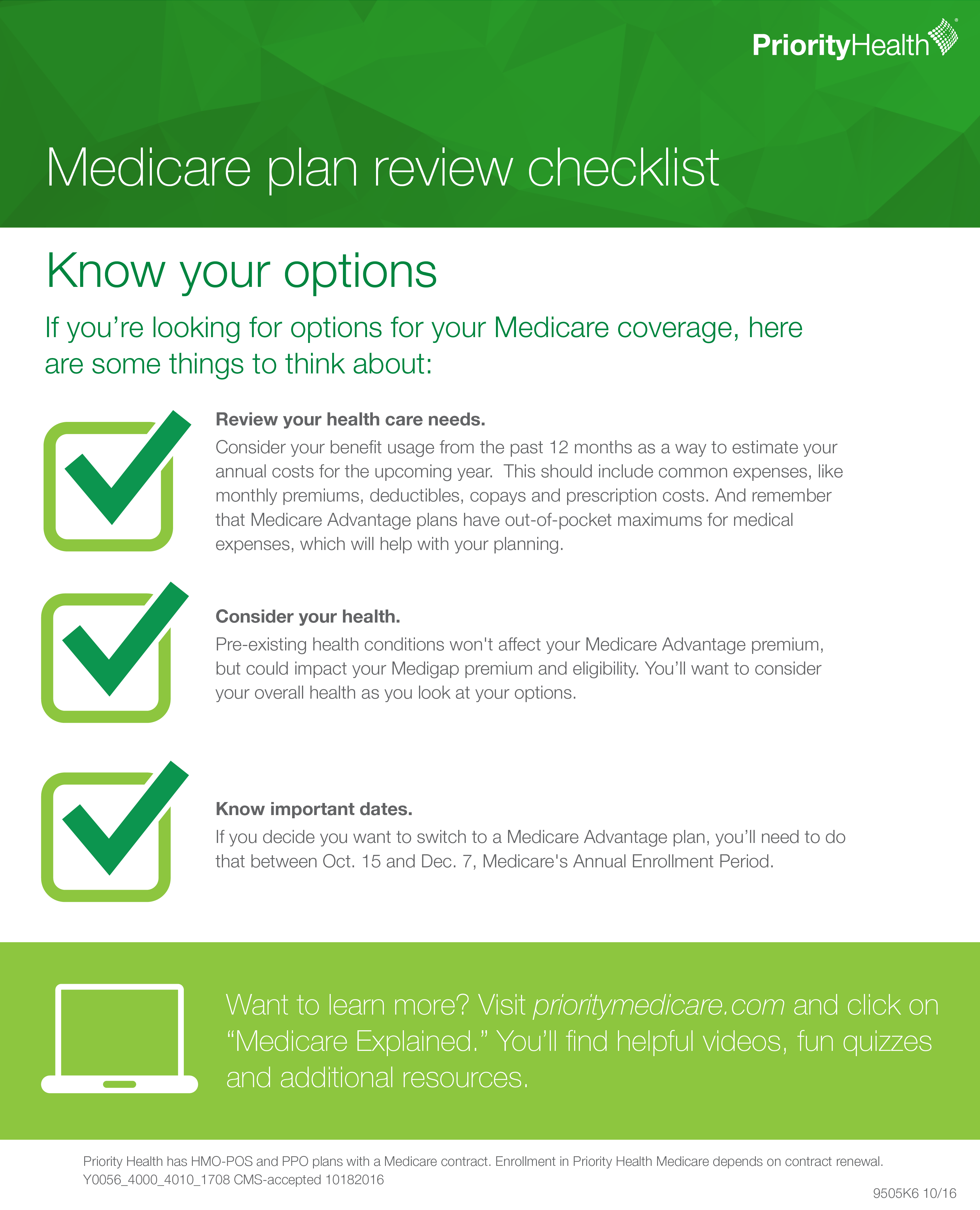Right now in Michigan, many Medicare beneficiaries are facing an increase in their Medigap plan premium.
If you’re one of those individuals (or you just want to explore alternative plans), you have options. Here are some tips to make the process easier and help you decide what’s best for you:
What Medicare plans are available?
There are two plan options that cover what Original Medicare (Parts A and B) doesn’t: Medicare Advantage and Medigap. Both are offered by private insurance companies and both have a monthly premium in addition to your Part B premium (although some Medicare Advantage plans offer a $0 premium). Original Medicare traditionally covers 80 percent of the costs you may incur. Both Medicare Advantage and Medigap plans help to cover the remaining 20 percent.
- Medicare Advantage plans offer everything Original Medicare does, plus more. Most Medicare Advantage plans include prescription drug coverage and extras such as dental coverage and gym memberships, as well as services to help you manage your health. Medicare Advantage plans tend to have lower premiums and offer a network of doctors, but some also offer out-of-network coverage.
- Medigap plans work side-by-side with Original Medicare and help pay deductibles, coinsurance or copayments that Original Medicare doesn’t cover. With a Medigap plan, you can go to any doctor that participates with Medicare. However, these plans don’t include prescription drug coverage, so you’ll need to purchase a Part D plan separately.

When can I switch health plans?
It’s important to understand when you can make a change to your plan. Generally speaking, if you’re thinking of switching to a new or a different Medicare Advantage plan, you can only do so between Oct. 15 and Dec. 7 each year – Medicare’s Annual Enrollment Period. When enrolling in a Medicare Advantage plan, you cannot be denied coverage or be charged a higher premium due to pre-existing conditions.
If you’re thinking of switching to a new or different Medigap plan, you’ll want to keep in mind that there are small windows of time when you’re able to join a Medigap plan without needing a health status review to determine the premium you’ll pay, called either your open enrollment period or guaranteed issue period. This is generally around your 65th birthday or if you have another qualifying event. Depending on your health status, you could be required to pay more for coverage if you apply for a Medigap plan outside of these windows.
Determine What Elements Are Important to You.
Lower monthly premiums
If you choose a Medicare Advantage plan, you’ll generally have lower monthly premiums but will be responsible for copayments and coinsurance when you seek care. But the reduced monthly premium rate, $0 to $200, can pay off if you don’t visit the doctor too frequently. And, typically Medicare Advantage plans include prescription drug coverage when you select a Medicare Advantage with Prescription Drug (MAPD).
Lower care costs
The premium on one of the most popular Medigap plans, Plan F, on the other hand, starts at more than $100 and goes up as you age reaching as high as $500. And, you’ll need to purchase a separate Part D prescription plan that may also have a monthly premium. However, your costs when you receive care such as your copayments and coinsurance are reduced.
Value-Add Components
With a Medicare Advantage plan, you’ll have access to extras not included with a Medigap plan – such as a gym membership or at home fitness kits, dental, vision and hearing coverage options, medication reviews and more.
“Maximum out-of-pocket” amount
Medicare Advantage plans have a maximum amount that members will pay out of pocket for medical expenses. Different plans have different maximums, but once you spend that much, the plan pays 100 percent of your covered services. You’ll know upfront the most you could possibly spend in a year for your medical care costs. Medigap plans do not have a cap for the amount out of pocket you could pay. For example, you could end up paying 10 percent, or $10,000, from a $100,000 hospital bill.
Increased Flexibility
With a Medigap plan, you can see any provider who participates with Medicare for your health care needs. Medicare Advantage plans are built around a network of providers, but there are plans that have a larger network of providers available. Many Medicare Advantage plans also offer out-of-network coverage options, just make sure that the coverage includes out-of-network providers in and out of Michigan. Remember that Medicare Advantage plans include coverage for emergency room and urgent care visits, including a hospital stay if you need to be admitted, no matter where you are in the United States. Some even offer worldwide emergency and urgent care coverage.
You have many options when it comes to your Medicare plan. You can make the right decision for you by learning more about your options, looking at your health care needs and determining what is important for your lifestyle.
To learn more, download Priority Health’s guide to selecting the right Medicare plan, contact Priority Health at 866.544.4465 or visit prioritymedicare.com. You can also visit medicare.gov to see what plans are available near you.



